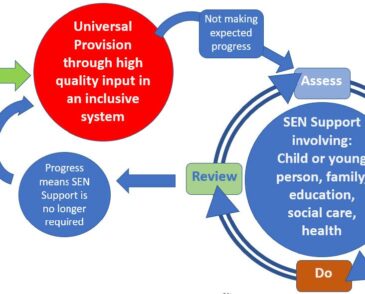

Last Updated - December 28, 2024
The graduated approach
The SEND Code of Practice says:
Where a pupil is identified as having SEN, schools should take action to remove barriers to learning and put effective special educational provision in place.
(SEND Code of Practice section 6.44)
When your child or young person is identified has having Special Educational Needs and/or Disabilities (SEND), the school should be able to:
- identify and decide the SEND support your child or young person needs in order to make progress
- put this SEND support in place
- and regularly check how well it is working using a graduated approach
They should do this using the following four steps.
Assess
Teaching staff should work with the SENDCO to assess your child or young person’s needs, so that they give the right support. They should involve you in this and, where possible, seek your child or young person’s views. They should talk to you about this first and should take any concerns you may have brought to their attention seriously. Schools can and should involve specialists, such as educational psychology or speech and language therapy, to provide further advice and support if your child continues to make little progress or work at substantially lower levels than expected.
Plan
If the school decides that your child or young person needs SEND support it must tell you or your young person directly if they are over 16. The school should agree the outcomes that will be set, what help will be provided and a date for progress to be reviewed with you or your young person. The school should draw up a plan, involving you and your child, focusing on the outcomes your child needs and wants to achieve and detailing how the school will support them to achieve these. Schools should record details of the actions they are taking under SEND support.
Do
Your child’ or young person’s class or subject teacher is usually responsible for the work that is done with your child or young person, and should work closely with any teaching assistants or specialist staff involved. The school should tell you or your young person who is responsible for the support your child or young person receives. The SENDCO will usually works with class and subject teachers to plan and deliver support, and keep a record of this. Everyone in school who works with your child or young person should be aware of their needs and the plan in place to address them.
Review
The school should review your child’ or young person’s progress, and the difference that the help your child or young person has been given has made, on the date agreed in the plan. You and your child or young person should meet with school at least three times a year and be involved in the review and in planning the next step. If your child or young person has not responded to the help they were given, the review should decide what can be done next, which should be recorded in the records. This may include more or different help.
It is up to schools to decide how to keep their records but they should be able to provide clear and accessible information to you about your child’s support and progress. SEND support meetings should be in addition to scheduled parents’ evening meetings. The school must provide a report at least once a year on your child or young person’s progress.
To get a more in depth understanding of SEND support you may want to look at You may want to look at:
- Torbay Early Years Graduated Approach Toolkit – children below age 5
- SEND Support and Provision (Graduated Response Toolkits) – children of compulsory school age (5 – 16)
- Age 16-18 SEND Support and Provision Toolkit
- A SEND Support and Provision Toolkit for young people aged 19 – 25 is currently in the process of being developed and will be coming soon.
If, following a period of time at SEND Support stage, your child or young person is still not making the expected progress, you, your young person if over the age of 16 or the school can ask for an Education, Health and Care (EHC) needs assessment.
